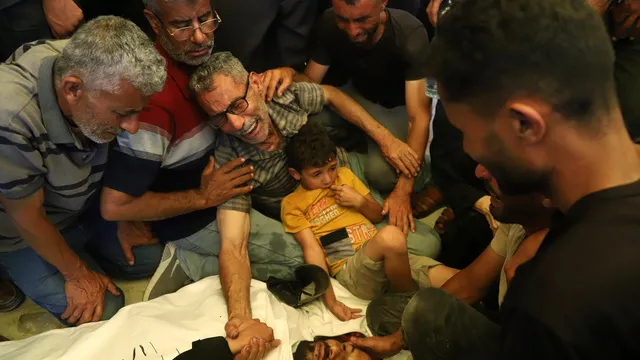
Israeli fire kills 17 Palestinians near Gaza aid sites
2025-06-12 07:31- At least 17 Palestinians were killed and more injured as they attempted to access aid distribution sites run by the Gaza Humanitarian Foundation.
- The Israeli military's actions raise concerns about the safety and effectiveness of new aid distribution efforts amidst an escalating humanitarian crisis.
- The situation highlights the ongoing conflict's tragic impact on civilians in Gaza and underscores the urgent need for effective humanitarian intervention.
Express your sentiment!
Insights
In the Gaza Strip, recent violent incidents have resulted in considerable casualties among Palestinians as they sought food aid amid an ongoing humanitarian crisis. Health officials report that at least 17 Palestinians were killed and many others injured when Israeli forces opened fire as crowds approached US-backed aid distribution centers. These locations, managed by the Gaza Humanitarian Foundation, were intended to provide much-needed support amidst worsening conditions, but residents report feeling unsafe due to repeated gunfire. Many had arrived early in hopes of receiving food, traveling from afar due to limited supplies. Eyewitness accounts indicate a chaotic scene, with gunfire erupting near a roundabout, raising fears that aid efforts have turned deadly. In late October 2023, tensions escalated following a surprise attack by Hamas militants on southern Israel, leading to a substantial military response from Israel. Since that attack, the conflict has claimed thousands of lives, disproportionally affecting the Palestinian population in Gaza. Israeli military operations have been intensifying, including a systematic campaign targeting alleged militant positions while also impacting civilians attempting to access humanitarian aid. The recent operations have drawn international scrutiny over the approach taken toward aid distribution in heavily impacted areas, critiqued as inadequate by various organizations. Moreover, the Palestinian health ministry has indicated that the conflict has led to an alarming death toll, with estimates reporting over 54,800 fatalities since the onset of military actions. Many humanitarian groups argue that the new distribution system established by the Gaza Humanitarian Foundation lacks effectiveness and fairness, compelling families to navigate dangerous situations just to seek food and basic necessities. The newly devised aid strategy has been met with criticism and accusations that it enables further militarization of humanitarian assistance, exacerbating the struggle for survival for those in Gaza. Palestinians report that armed local groups, working closely with the Israeli military, have contributed to the turmoil by engaging with crowds that gather at aid sites, leading to violent confrontations. The implications of this situation resonate throughout Gaza, with many feeling desperate as the humanitarian crisis unfolds without sufficient international intervention or support. Amid calls for accountability and improved aid mechanisms, the situation remains tense as civilians continue to bear the brunt of the ongoing conflict.
Contexts
The current situation in Gaza regarding aid distribution as of June 2025 is critical, characterized by ongoing humanitarian crises exacerbated by political instability, economic challenges, and infrastructural damage. The region has been grappling with extensive needs since the escalation of conflicts, leading to significant population displacement and exacerbating poverty levels. This has made it increasingly urgent to streamline and enhance the delivery of humanitarian aid to those affected. Various international organizations, including the United Nations and non-governmental organizations, have been actively working to provide necessary relief; however, there are numerous obstacles that hinder effective aid distribution. Access to the affected areas remains one of the most significant challenges. Checkpoints, restrictions in movement, and ongoing conflicts continue to impede the timely delivery of much-needed supplies such as food, medical assistance, and shelter materials. Additionally, a blockage in the supply chain has emerged as a critical barrier, as vital goods are often delayed or entirely prevented from entering Gaza due to political tensions. This situation has resulted in a backlog of essential items that, if not delivered promptly, could have dire consequences for those in need, including increasing malnutrition rates and limiting access to health care. International humanitarian efforts have been stepping up to address these issues, yet the coordination between various aid agencies often faces strains due to differences in operational protocols and priorities. Moreover, funding for these initiatives is regularly in flux, leading to uncertainty in planning and executing relief projects. There are ongoing calls for increased transparency and collaboration among NGOs and local entities to manage resources effectively and reach the most vulnerable populations. Efforts to innovate aid delivery methods, such as utilizing local vendors and mobile distributions, have shown promise in bypassing some logistical barriers. In conclusion, while the situation in Gaza's aid distribution remains markedly precarious, the collective determination of international and local actors to improve conditions is evident. Continuous advocacy for open access to humanitarian assistance and a sustainable solution to the underlying political issues will be vital in fostering a resilient recovery for Gaza. Addressing these structural challenges is paramount to ensuring that aid reaches those who need it most and ultimately supports the rebuilding of the region's social fabric.